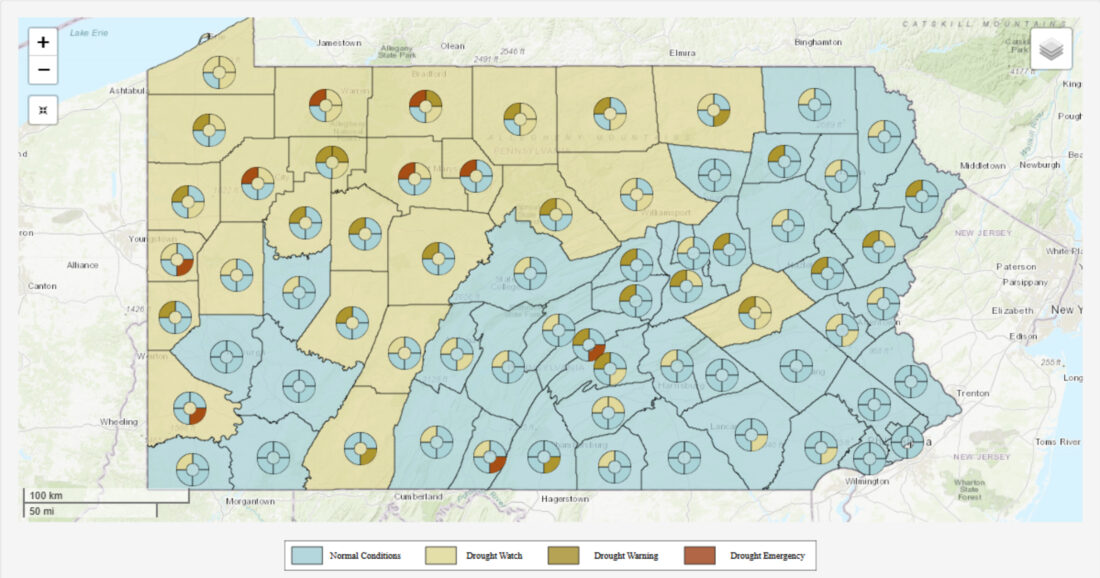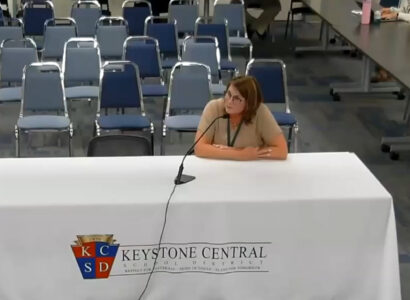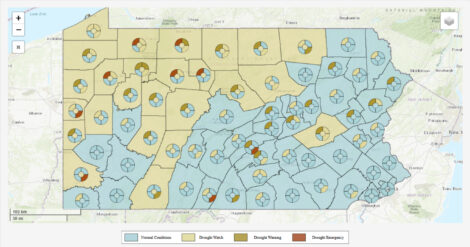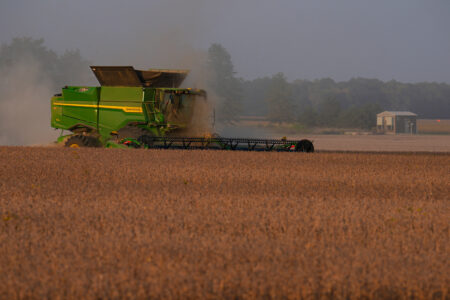DEP declares drought in Clinton, other counties

GRAPHIC BY DEP Clinton County is among 25 counties in Pennsylvania that have been declared under a drought watch by the Department of Environmental Protection.
LOCK HAVEN — Clinton County is among 25 counties within the Commonwealth of Pennsylvania to be listed under drought conditions, according to the Department of Environmental Protection.
The state’s Drought Task Force announced Monday the following counties are under a drought watch as consistent rain continues to elude a majority of the state: Beaver, Bradford, Butler, Cambria, Cameron, Clarion, Clearfield, Clinton, Crawford, Elk, Erie, Forest, Indiana, Jefferson, Lawrence, Lycoming, McKean, Mercer, Potter, Schuylkill, Somerset, Tioga, Venango, Warren, Washington counties are under a Drought Watch.
“Pennsylvania received very little rain over the summer. We want residents to be aware of these dry conditions and be mindful of their water use,” said DEP Secretary Jessica Shirley. “DEP makes drought declarations based on long-term trends. A severe thunderstorm or a rainy week may not lift the drought status for a particular area.”
The Commonwealth broke down the different stages of drought conditions which can be declared by state officials:
— Drought Watch: A Drought Watch is typically declared for a county with three of the four factors in a “watch” status. Residents are encouraged, but not required, to voluntarily reduce their water use by five to ten percent.
— Drought Warning: A Drought Warning is typically declared for a county with three of the four indicators in “warning” status. Residents are encouraged, but not required, to reduce their water use by 10-15 percent.
— Drought Emergency: If conditions become more severe a Drought Emergency can be declared by the Governor and emergency water restrictions can be implemented. In the unlikely event of a drought emergency, water suppliers and/or municipal governments will guide residents about water use and conservation.
Drought declarations are based on four factors: precipitation, stream flows, groundwater levels and soil moisture. The DEP Drought Coordinator monitors these indicators in close partnership with the U.S. Geological Survey (USGS), which maintains gauges in streams and wells in many locations across Pennsylvania.
DEP makes its drought declarations after assessing the departures from normal ranges for periods of 3-12 months.
DEP also factors in information it receives from public water suppliers. DEP will not implement mandatory water use restrictions outside of a Drought Emergency. Individual public water systems may implement their own conservation measures. While not required, residents and businesses are encouraged to voluntarily conserve water by reducing nonessential water use.
DEP provides the following tips to help conserve water:
— Run the dishwasher and washing machine less often and only with full loads.
— Shorten the time you let the water run to warm up before showering and take shorter showers. The shower and toilet are the two biggest indoor water guzzlers.
— Check for and repair household leaks. For example, a leaking toilet can waste up to 200 gallons of water daily.
— Install low-flow plumbing fixtures and aerators on faucets.
— Replace older appliances with high efficiency, front-loading models that use about 30 percent less water and 40 to 50 percent less energy.
Just a few weeks ago, the City of Lock Haven was encouraging its water customers to conserve water due to a lack of rain in the area.
In late September, the city took to social media to encourage residents and water customers to consider conserving water as the drought conditions neared.
At the time, City Manager Gregory Wilson said the water levels at the two city-owned reservoirs — Ohl Reservoir in Greene Township and Keller Reservoir in Wayne Township — weren’t at dangerous levels; the city didn’t want to wait until the last minute to encourage conservation of water.
“While there are still several months of water on-hand, we don’t want to wait until the last minute to talk to residents and especially businesses and industries about taking steps to reduce water consumption. As you look at the forecast, there are only a couple days that have rain predicted,” Wilson told The Express at the time. “The reservoirs, of course, the great collectors of rainwater, that is then treated and sustains our homes and enables businesses and industrial operations from McElhattan all the way up Route 64.”
According to Wilson, Ohl — which is upstream from Keller — has a normal pool elevation of about 1,665 feet (575,708,902 gallons). Due to a lack of rain, it is down 2.6 feet from its normal elevation (462,717,999 gallons on hand).
For Keller, its normal elevation is 908 feet (92,400,000 gallons). Currently, it’s slightly above its normal levels at 94,039,092 gallons.
Weather-wise, a quarter- to a half-inch of rain is forecast for overnight today into Wednesday, which will help — but, with rainfall deficits measured in multiple inches at this point, will not be sufficient to put any kind of serious dent into the drought.
Long-range weather models, while imprecise and subject to change, are showing a shift to a more active pattern by the middle of October. If that ends up happening, we may enjoy at least enough rain to keep us stable, although making serious gains on the drought is going to require a particularly slow and steady rain over a prolonged period — or a procession of lesser such systems.






